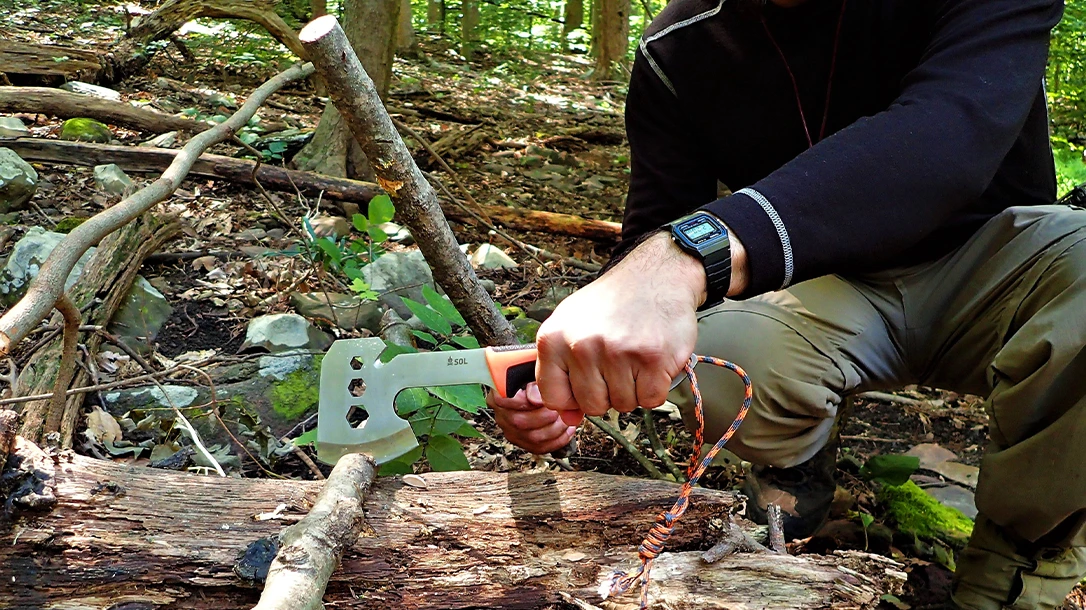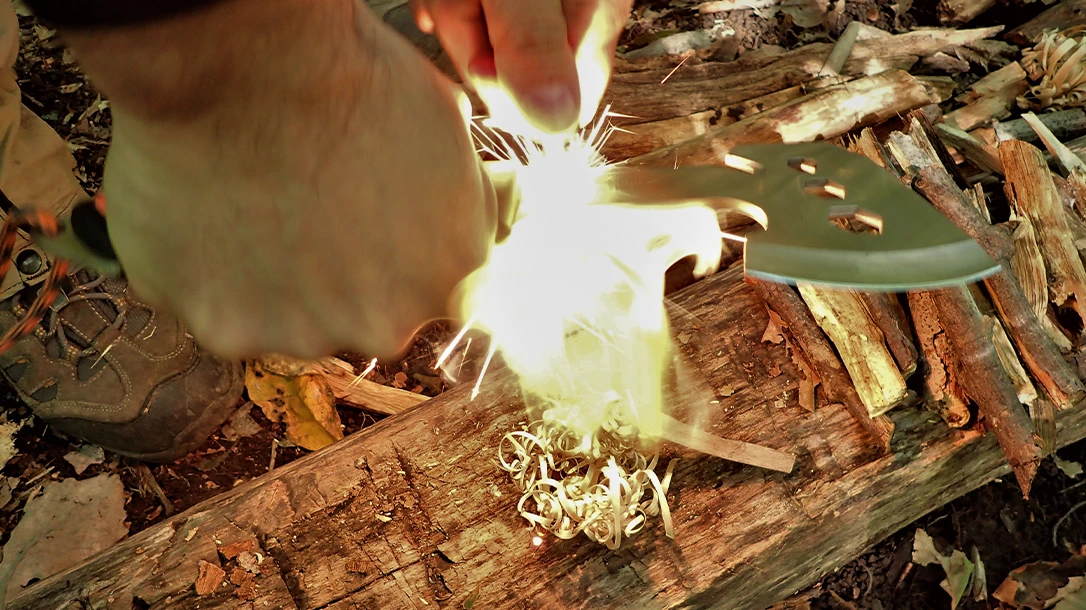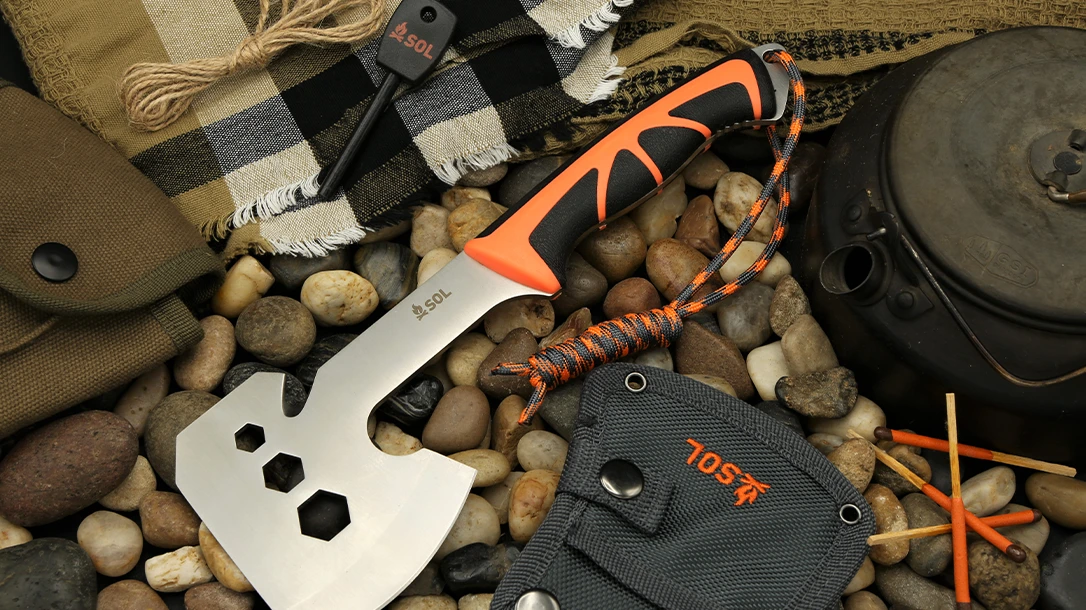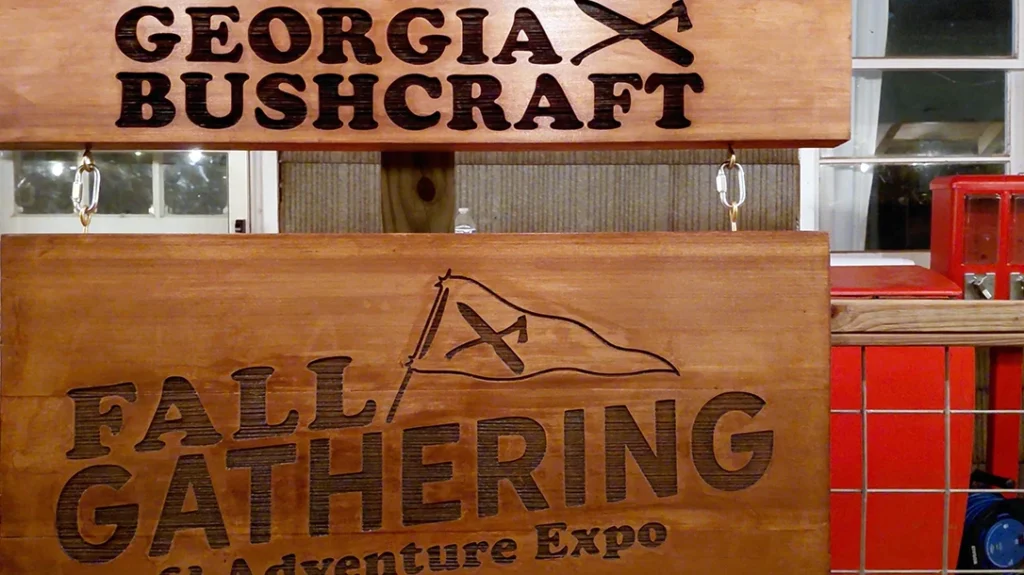Adventure Ready Brands is all about quenching that adventurous thirst for exploration. Their mission? To roll out the most cutting-edge survival gear for every setting—whether you’re trekking through the wilderness, cruising on water, or soaring through the skies. They tap into the expertise of survival specialists and wilderness medicine professionals to refine their products year after year.
Beyond the well-known Survive Outdoors Longer®, they proudly manage around ten other popular brands, including Ben’s®, Natrapel®, and Adventure Medical Kits®. Adventure Ready Brands thrives on the idea that adaptability and change are the secret ingredients to an adventurous life!
Stoke Camp Hatchet by SOL
When it comes to adventures and survival gear, SOL—short for Survive Outdoors Longer—immediately springs to mind. This brand has established itself as the go-to source for innovative survival kits, emergency shelters, fire-starting tools, and signaling devices, truly embodying the spirit of adventure!
Advertisement — Continue Reading Below
Take the Stoke Camp Hatchet, for instance—it’s the ultimate multi-tasking fire-starting companion. With an integrated rope cutter, you can snip a piece of the included tinder cord and easily ignite it with the ferrocerium rod and blade. Weighing in at just 10 ounces, this lightweight hatchet is crafted from durable 420-stainless steel and features a sure-grip handle made from Polypropylene/TPR (thermoplastic rubber).
And if you find yourself in need of a wrench while camping, fear not! The Stoke comes with three handy hex wrenches. Additionally, it features a riveted nylon belt sheath to protect the blade and keep it securely stored. The sheath even has room for the ferrocerium rod. And here’s a clever twist: that integrated rope cutter doubles as a bottle opener, so you can kick back and toast your camping triumphs by the fire. With the Stoke, you’ll be well-equipped to tackle any outdoor challenge—whether it involves chopping wood or cracking open a cold drink!

Advertisement — Continue Reading Below
Crafting with the SOL Stoke Hatchet
I wielded the Stoke like a chef wields a knife, gripping it closer to the handle for greater finesse while tackling various carving and notching techniques. Partnering it with a hefty mallet, I dubbed it my “energy maximizer.” After all, accuracy and safety are paramount.
My mission? Crafting essential camp gear like tarp stakes, trap components, and a sturdy tripod. Not to mention, I had fire-starting tasks up my sleeve, ready to split wood and whip up feather sticks for tinder.
As the days grew cooler, the leaves transformed into a stunning autumn palette, making my stroll feel like I’d stepped into a living painting. With temperatures still comfortable, I chose to start a modest campfire, using my compact Uberleben twig stove for some precise cooking before prepping wood for the fire. First things first, though—I needed to set up my tarp over the hammock, which required some stakes.
Advertisement — Continue Reading Below
Stakes
I scored some semi-green wood from a recently toppled oak tree and got to work salvaging some straight branches for my crafting endeavors. Armed with my trusty Stoke, I transformed these pieces into stakes, trap components, and even a tripod. Oaks may be rugged, but that’s just how I like my materials!
I lopped off a few long branches, each about the thickness of a thumb to a broomstick, perfect for stakes. I started by giving the tops a flat 90-degree chop and then, about a forearm’s length down, I sliced in a cool 45-degree angle for the pointy end that would dig into the ground. Rinse and repeat, and voilà—I had four stakes ready to rock, one of which even came with a natural forked end for an automatic notch. Talk about convenient!
Next, I added notches for cordage to attach my tarp. I crafted simple 7-notches into three of my stakes, placing them near the flat top. For the first method, I performed a deft 90-degree chop for my stop-cut, ensuring I didn’t overdo it—just a third of the way in. Then, treating the Stoke like a knife, I carved up to that stop-cut with a little thumb-assisted push on the spine. That blade was sharp enough to make a skilled chef jealous!
Advertisement — Continue Reading Below
For the second method, I switched it up and used a baton for more precision. A few firm whacks on the back of the Stoke got my stop cut done in no time. After a couple of slices to carve out the notches, my stakes were officially complete. Shelter’s ready; I’m all set for whatever adventure lies ahead!
Making Traps:
When it comes to trap making, I can’t resist the charm of the figure-four trap. It’s a fantastic way to test both the sharpness and comfort of my cutting tool. Armed with my trusty Stoke, I whittled a long green stick down to about broomstick thickness, slicing it into three segments. I gave each end a 45-degree angle cut and carved out four notches, designed to hold the trap firmly in place.
To nail those stop cuts with precision, I brought out my trusty baton and made sure those notches were spot-on. I held the Stoke like a trusty knife, choking up on the handle for a bit more finesse. When it was time to channel my inner powerhouse, I switched to a modified chest-lever grip. In this position, I held the Stoke sideways—blade facing away from me—with my right thumb on the handle side, while my left thumb lent a helping, steadying hand. And just like that, whipping up a simple trap with the Stoke was a breeze!
Advertisement — Continue Reading Below

Fire Ignition
I kicked off my culinary adventure with a trusty little Uberleben wood stove, whipping up coffee and meals like a camp chef. First things first: I hunted for some dry maple sticks, about the size of my finger. Once I found a decent stash, I laid them out on my flat wooden workstation and got busy chopping them into finger-length pieces with my Stoke. Before long, I had a nice little pile of firewood ready to fuel the stove.
Now came the fun part: testing the edge sharpness of the Stoke by crafting some feather-sticks for tinder, which would team up with my SOL Ferrocerium rod. To make feather-sticks with a hatchet-style tool like mine, I stabilized the blade’s heel on a sturdy surface. If needed, a baton can help secure it in place. With one hand anchoring the hatchet, I took a dry stick with the other hand, gliding it back against the blade to create those feathery shavings. This method might be new to some, but trust me, it’s worth practicing!
Advertisement — Continue Reading Below
Here’s a quick tip: once the wood just starts to catch on the sharp edge, take it easy and draw it back slowly. Another method for crafting feather-sticks involves gripping the Stoke in my dominant hand, bracing the spine against my knee, and drawing the stick back against the blade. This technique is particularly effective when you’re kneeling or sitting—so get comfortable!
Finally, it was time for the grand spark show. I used the spine of the Stoke, which is a sharp, flat 90-degree angle, to shower sparks onto those feather-sticks. It took a few tries, but soon enough, I had fire! Success!
Crafting a Tripod
I whipped up the simplest tripod I’ve ever crafted. First, I chopped three sturdy poles, about 1 ½ to 2 inches thick—nothing too fancy. To amp up my speed and leverage, I decided to choke way back on the Stoke’s handle. Once I had my poles secured on a rock-solid oak workstation, I grabbed a baton to trim the ends. By hammering the back of the Stoke where I wanted the cuts, I sunk that blade in deep with one precise whack.
Advertisement — Continue Reading Below
One of the poles had a nifty forked end, perfect for my needs, while another boasted a forked piece right in the middle—ideal for hanging tongs or a pot. I steadied the bottoms of the poles and tied a simple reef knot (a square knot for the purists) about 12 inches from the top using a single piece of #36 bank line, which I neatly cut with the Stoke’s integrated rope cutter.
After setting up the tripod, I gave one pole a good twist. Voilà! More tension and a sturdier tripod. Finally, I reattached my trusty old pothook to the pole with the fork—mission accomplished, and all in a day’s work!
In Closing
The SOL Stoke Hatchet quickly became my trusty sidekick in the woods, helping me whip up all sorts of camp gear like stakes, wedges, a tripod, and even a cooking grill. I was splitting and chopping wood like a pro for my various projects and, of course, for the all-important fire. When it came to fire-making, the Stoke was a superstar. With its sharp stainless-steel blade, handy tinder cord lanyard, and reliable Ferrocerium rod, this Camp Hatchet made it a breeze to spark up a cozy fire no matter where my adventures took me! Unleash Your Skills with the SOL Hatchet
Advertisement — Continue Reading Below

SOL Stoke Camp Hatchet SPECS:
Overall Length: 10 7/8-inches
Blade: 3 inches
Width: 3 ¾-inches
Steel: 420 Stainless Steel
Handle Material: Polypropylene/TPR
Weight: 10 ounces (12 ounces w/sheath)
Sheath: Nylon
Multi-Tool Function: 3 sizes of Hex Wrenches
Integrated Rope Cutter
Ferrocerium Rod included
MSRP: $34.99


















